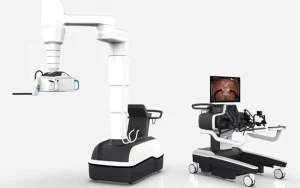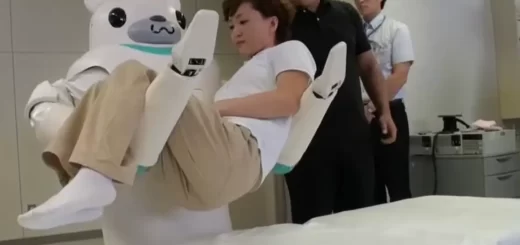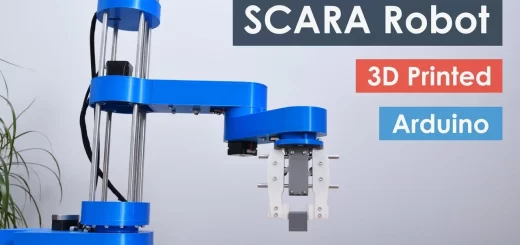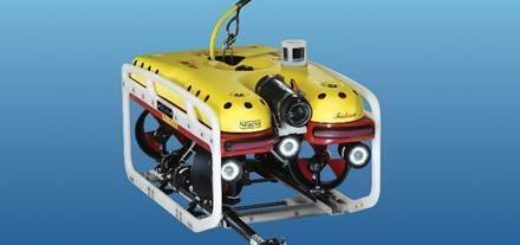Titan Medical’s Single-Port Robot (Enos System) features, advantages and disadvantages
Enos system provides both high-definition 3D and 2D views of the surgical site, giving surgeons a clear and detailed picture. Enos uses just one small incision, potentially leading to less pain and faster recovery for patients. Each robotic arm allows for a wider range of motion and dexterity compared to traditional laparoscopic instruments.
Enos System
The name “Enos” is a reference to the Greek god of travel and trade, reflecting the system’s portability and potential to make surgery more accessible. Titan Medical’s Single-Port Robot is also known as the Enos System and SPORT Surgical System. The name SPORT stands for Single Port Orifice Robotic Technology.
Titan Medical’s Single-Port Robot uses a single 25mm incision, minimizing scarring and potential complications compared to traditional multi-port surgeries. Each robotic arm has 7 degrees of freedom, mimicking human wrist movement for enhanced dexterity and maneuverability within the limited tight surgical space.
The robotic arms offer a wider range of motion compared to traditional laparoscopic instruments. The system offers both 3D and 2D high-definition cameras, providing surgeons with different perspectives during surgery, It allows a clear and detailed view of the surgical site.
The system’s compact design and mobile cart allow for easy maneuverability in the operating room. Unlike most traditional robotic surgery with multiple incisions, the SPORT offers less tissue trauma, and scarring, and faster recovery times for patients.
The patient cart is designed for maneuverability and ease of use in different surgical settings. The surgeon console features an intuitive interface with haptic feedback, allowing for natural and precise control. Quickly swappable instruments cater to various surgical needs within a single incision.
Enos system uses many surgical instruments that can be easily swapped out during surgery, increasing its versatility, and taking up less space than traditional robotic systems. Due to its smaller size and single-port design, Enos system could be more affordable for hospitals compared to other robotic surgery systems. Enos system could further advance the field of minimally invasive surgery, offering benefits to both patients and surgeons.
Advantages of Titan Medical’s Single-Port Robot
With only one incision, patients potentially experience less pain, faster recovery, and smaller scars than traditional multi-port surgery. The single-port design allows for a more natural hand-eye coordination for surgeons, potentially reducing fatigue and improving precision.
Due to its smaller size and fewer components, the Enos system could be more affordable for hospitals compared to traditional robotic surgery systems. The compact design and ease of maneuverability could make the Enos system more adaptable to various operating rooms, potentially increasing access to minimally invasive surgery in different settings.
A minimally invasive approach potentially leads to faster recovery times and less pain. Smaller incisions translate to reduced scarring, offering cosmetic and psychological benefits. Envisioned for use in various general surgery procedures, potentially expanding access to minimally invasive techniques.
Smaller incision sizes could lead to faster healing, less pain for patients, and smaller scars compared to traditional laparoscopic surgery with multiple incisions. The surgeon console design aims to reduce fatigue and improve comfort during long procedures. The system’s design might make robotic surgery more accessible to smaller hospitals and clinics.
The single-incision design minimizes tissue disruption, potentially leading to faster healing times, and improved cosmetic outcomes. The robotic arms provide tremor filtering and enhanced dexterity, allowing surgeons to operate with greater precision and control while maintaining a comfortable posture.
The robot‘s design offers better wrist angles and tremor filtration, potentially reducing surgeon fatigue and improving control. Dual articulating arms with 7 degrees of freedom provide a wider range of motion and maneuverability compared to laparoscopic instruments.
The 3D and 2D camera system offers a magnified and detailed view of the surgical field, potentially improving surgical decision-making and reducing the risk of complications, aiding in accuracy and efficiency.
The smaller size and single-port design could translate to lower costs for hospitals compared to traditional robotic systems with multiple incisions. The portability and ease of use of the Enos system could make minimally invasive surgery more accessible in resource-limited settings. Interchangeable instruments allow for adaptation to various surgical procedures. Easier maneuverability in the operating room compared to larger robotic systems.
Disadvantages of Titan Medical’s Single-Port Robot
The Enos system is still under development, It has not yet been widely adopted in clinical practice. and it has limited clinical data compared to established robotic surgery platforms like da Vinci. Long-term data on its efficacy and safety compared to existing options is lacking. Single-port surgery presents unique challenges in terms of instrument clashing and limited access. The Enos system needs to overcome these limitations to ensure efficient and safe procedures.
Surgeons need to adapt to the single-port approach and the Enos system‘s specific controls, which could increase training time and costs. While the system offers interchangeable instruments, the current options might be limited compared to traditional multi-port surgery, potentially restricting its application in complex procedures.
Titan Medical faces established players like Intuitive Surgical with their da Vinci SP system, requiring them to effectively demonstrate the Enos system‘s unique advantages to gain market share. As a novel system, it may face initial resistance from surgeons accustomed to traditional robotic surgery.
The single-port design presents unique challenges in terms of instrument manipulation and visualization compared to traditional multi-port approaches. While potentially cheaper than other robotic systems, the overall cost-effectiveness of the Enos system needs further evaluation considering its limited clinical data and potential for increased operative times.
Surgeons need to adapt their skills and techniques to operate the Enos system effectively, which could lead to increased training time and costs. The current instrument selection for the Enos system is limited compared to other robotic platforms, potentially restricting its use in complex procedures.
The Enos system requires surgeon training and adaptation to a new surgical approach, Currently, fewer instrument options compared to established systems. New technology might come with a higher initial investment for hospitals. Mastering the new robotic interface and single-port approach might require additional training and practice.
You can follow science online on YouTube from this link: Science online
Grace robot nurse advantages and disadvantages, What is Grace the robot used for?
Moxi, the AI-powered robot nurse assistant, Can Moxi robots replace human nurses?
Healthcare robotics, Nursing care robots review, types, advantages, disadvantages, and uses
Moxie robot advantages, disadvantages and what does a moxie robot do?
Robotic surgery cons, pros, uses and How does robotic surgery work?
Artificial intelligence in medical field advantages & how AI medical diagnosis changes medicine
Surgical robot types, advantages, disadvantages, How is robotic surgery different from traditional
Applications of Artificial intelligence in the medical field and Healthcare
Importance of Artificial intelligence in healthcare and medicine
Domestic robot or Service Robot types, advantages and disadvantages




